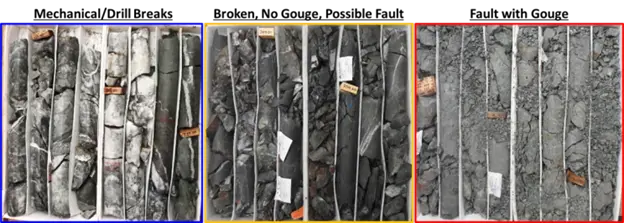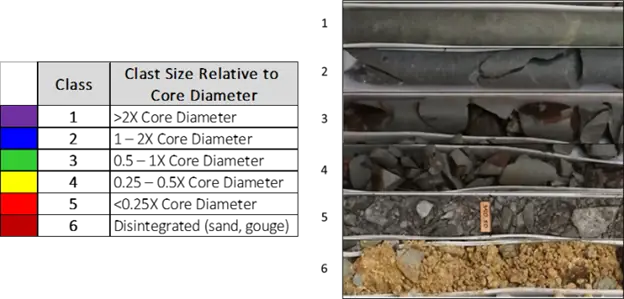By leveraging machine learning based image recognition, we can collect data down to whatever minimum resolution we want (in this case intervals of >= 5 cm). Instead of being concerned that intervals of significance are being blurred or lost within larger logged intervals, we can focus observations to knowing how broken the core is without having to review thousands of metres of box photos. This system is meant to be a proxy for manual review of the core photos. You can visualize this index in your 3D modelling environment and link it with your structural, lithological, or alteration models to inform your geotechnical domain model. Improving your structural model and understanding the variability within the fault zones by using this index is more valuable than having an additional 100,000 m of RQD that needs to be manually reviewed.
Most importantly, we delegate the tedious image classification to the computer and leave the interpretation of the significance of these features to the engineers and geologists.
References
Bieniawski ZT. 1989. Engineering rock mass classification. New York, Wiley
Bieniawski ZT. 1976. Rock mass classification in rock engineering. Explor Rock Eng, Proc Symp 1:97–106
Deere, D. & Deere, D. W. (1988). The rock quality designation (RQD) index in practice. In Rock classification systems for engineering purposes. ASTM STP 984, Louis Kirkaldie, Ed., American Society for Testing and Materials, Philadelphia, 1988, pp. 9 1- 101.
Laubscher DH. 1990. A geomechanics classification system for the rating of rock mass in mine design. Journal of South African Institute of Mining and Metallurgy. 90:257-273.
Jakubec J, and DH Laubscher. 2000. The MRMR rock mass rating classification system in mining practice. In: Proceedings of MassMin 2000, Brisbane, Australia. 9 p.
Pells, P. J., Bieniawski, Z. T., Hencher, S. R., & Pells, S. E. (2017). Rock quality designation (RQD): time to rest in peace. Canadian Geotechnical Journal, 54(6), 825-834.
Tims S, A Caté, A LeRiche. 2022. Novel approaches in geotechnical classification using machine learning. Slope Stability 2022, Tucson, Arizona.


